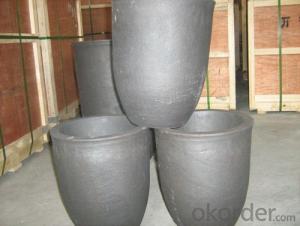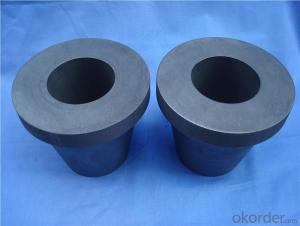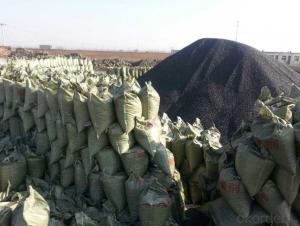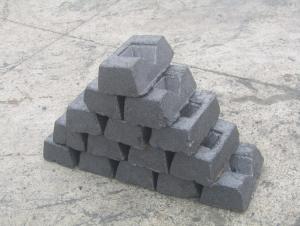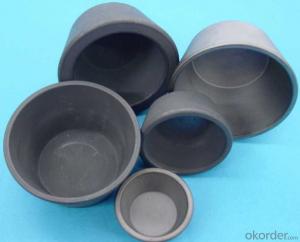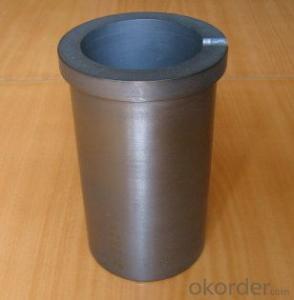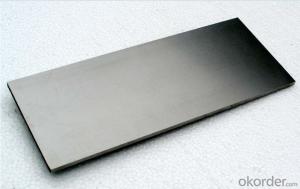Graphite Crucibles Wholesell/High Strengh CNBM
- Loading Port:
- Tianjin
- Payment Terms:
- TT OR LC
- Min Order Qty:
- 0 m.t.
- Supply Capability:
- 10000 m.t./month
OKorder Service Pledge
OKorder Financial Service
You Might Also Like
Features
1.Long working lifetime: its working lifetime is increased 3-5 times over normal clay-crucible due to the compact body formed under high pressure.
2.High thermal conductivity: highdensity body and low apparent porosity greatly improve its heat conductivity.
3.Newstyle materials: new heat conduction material ensures faster heat conductivity and pollution-free product, reduces adherent slag.
4.Resistance to corrosion:better anti-corrosion than normal clay-crucible.
5.Resistance to oxidation: advanced process dramatically improves its oxidation resistance, which ensures persistent heat conductivity and long working lifetime.
6.High-strength: high-density body and logical structure make the product better compression property.
7.Eco-friendly: energy-efficient and pollution-free, not only ensure metal product purity, but also ensure sustainable development on environment.
8.Multi-function: Can be used in induction graphite crucible furnace
Specification
Bulk Density | g/cc | 1.70-1.88 |
Specific Resistance | μΩ.m | 6.0-15.0 |
Compressive Strength | MPa | 30-80 |
Bending Strength | MPa | 20-45 |
Shore hardness | 30-70 | |
C.T.E.(100-600°C) | x10-6 /°C | 2.5-5.5 |
Ash | % | 0.01-0.2 |
Maximum Grain Size | mm | 0.044-0 |
Product Uses
1. Graphite crucible cannot be exposed in moisture, and must be placed in indoor dry place or wooden shelf. Maintain ventilated. Moisture is strictly prohibited. Damped crucible is likely to crack.
2. Each crucible, especially damped ones, must be preheated and roasted in drying equipment or next to a ground furnace before use. The roasting temperature should start from a low temperature of 100°C below. Roast it to 150°C at a speed of not higher than 30°C per hour. Preserve the heat for about 8 hours and then dry it. The crucible dried next to a ground furnace should be placed at least for one shift, and often turned to change direction, till workers feel the internal wall of crucible is hot.
3. The melting time for the first time should be at least twice of the normal melting time, in order to avoid cracking inside the crucible due to heating up too fast, or even cracking immediately when the fire sets on.
4. Handle with care. Falling or shaking is strictly forbidden in order to present cracking. Crucible should be placed below the mouth of furnace to prevent the furnace lid abrading the upper edge of the crucible and thus affecting the capacity.
5. Pour out the remaining cold metals inside the crucible after use, and then add new materials. Carefully and gently add new materials into the crucible. Feed materials according to the capacity of crucible. It is not allowed to feed too many materials, in order to prevent crucible from swelling or bursting.
6. Knock gently to remove slags and cokes on the internal and external wall of the crucible. Avoid damaging the crucible body.
7. In the melting process, do not add chloride solvents in order not to corrode the crucible. For the furnace that uses oil and coal gas as fuels, the oil wind should not reach one part of the crucible directly. Turn around the crucible from time to time, in order to avoid local damage.
8. Clamps and other discharging tools should comply with the shape of the crucible. During furnace discharging, remove the cokes on the external wall of the crucible, and lower the furnace temperature; do not discharge at high temperature after stopping blasting. Clamp the upper and middle parts instead of the top of the crucible in order not to damage the crucible. Graphite crucible is used mainly to melt gold, silver and other precious metals.

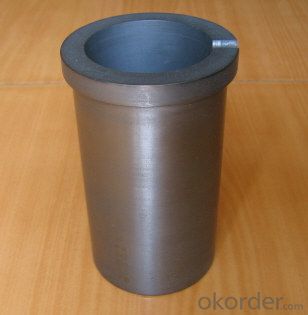
- Q: How does carbon affect the pH of water bodies?
- Carbon can affect the pH of water bodies through the process of carbon dioxide dissolution. When carbon dioxide dissolves in water, it forms carbonic acid, leading to a decrease in pH and making the water more acidic. This can have significant impacts on aquatic ecosystems and the organisms that inhabit them.
- Q: How does carbon impact the growth and development of plants?
- Carbon is essential for the growth and development of plants as it is a key component of photosynthesis. Through this process, plants convert carbon dioxide into glucose, their main source of energy. Carbon also plays a crucial role in forming the structural molecules of plants, such as cellulose, lignin, and proteins. Overall, carbon is vital for the overall health, productivity, and survival of plants.
- Q: What are greenhouse gases?
- Greenhouse gases are gases that trap heat in the Earth's atmosphere, contributing to the greenhouse effect. They include carbon dioxide (CO2), methane (CH4), nitrous oxide (N2O), and fluorinated gases. These gases are naturally occurring and are also emitted through human activities such as burning fossil fuels, deforestation, and industrial processes. The greenhouse effect is vital for life on Earth as it helps to keep the planet warm enough to support life. However, excessive emissions of greenhouse gases have caused an imbalance in the atmosphere, leading to global warming and climate change. It is important to reduce greenhouse gas emissions and find sustainable alternatives to mitigate the impacts of these gases on our planet.
- Q: How is carbon stored in the Earth's crust?
- Carbon is stored in the Earth's crust in various forms and geological processes. One primary way carbon is stored is through the formation of sedimentary rocks such as limestone, dolomite, and chalk. These rocks are primarily composed of calcium carbonate, which is derived from the shells and skeletons of marine organisms that lived millions of years ago. Over time, these remains accumulate on the ocean floor and are compacted and cemented to form sedimentary rocks, effectively trapping carbon within them. Another way carbon is stored in the Earth's crust is through the process of carbonation. Carbon dioxide (CO2) from the atmosphere can dissolve in water and react with certain minerals such as basalt, forming carbonate minerals like calcite or magnesite. This process occurs naturally through chemical weathering and volcanic activity, and it helps sequester carbon within the Earth's crust. Additionally, organic carbon is stored in the form of fossil fuels such as coal, oil, and natural gas. These fossil fuels are the remains of ancient plants and microorganisms that lived and died millions of years ago. Over time, the organic matter is buried and subjected to high pressure and temperature, undergoing a process called diagenesis, which eventually converts it into fossil fuels. These deposits act as reservoirs of carbon in the Earth's crust. Overall, the Earth's crust acts as a significant carbon sink, effectively storing carbon through various processes such as the formation of sedimentary rocks, carbonation, and the accumulation of fossil fuels. However, it is important to note that human activities, particularly the burning of fossil fuels, are releasing substantial amounts of stored carbon into the atmosphere, contributing to global climate change.
- Q: Does anyone know what the definition of carbon storage is in ecology? Thank you
- 1, store it in a certain range.2 carbon storageAbout 2. No need to explain1 of the words is "popular carbon dioxide storage".. Current storage practices are generally to collect CO2 in the atmosphere and inject gas into the ground
- Q: How does carbon affect the preservation of historical artifacts?
- The preservation of historical artifacts can be affected by carbon in both positive and negative ways. On one hand, materials that contain carbon, such as paper, wood, and textiles, can deteriorate over time. They are easily influenced by environmental elements like temperature, humidity, and pollutants, which cause them to decay. Additionally, insects and rodents are attracted to carbon-based materials, worsening their deterioration. On the other hand, carbon-based substances like charcoal and carbonates are vital in artifact preservation. Charcoal, for instance, is useful for dating artifacts using carbon dating, offering valuable insights into their age and historical importance. Carbonates, such as calcium carbonate found in limestone, act as protective coatings, creating a barrier against environmental factors and preventing further decay. Furthermore, conservation techniques that involve carbon-based treatments, like using adhesives or polymers, can stabilize and strengthen fragile artifacts. These treatments enhance the artifact's resistance to environmental factors and provide structural support, thus extending its lifespan for future generations. It's important to acknowledge that while carbon-based materials have an impact on preserving historical artifacts, other factors like exposure to light, handling, and storage conditions also play significant roles. Therefore, a comprehensive preservation strategy should consider all these factors to ensure the longevity and conservation of these valuable historical artifacts.
- Q: What are the properties of carbon-based rubber?
- Carbon-based rubber has several properties that make it a versatile and widely used material. Firstly, it has excellent elasticity and flexibility, allowing it to stretch and return to its original shape without deformation. Additionally, it is highly resistant to abrasion, making it durable and long-lasting. Carbon-based rubber is also known for its good electrical conductivity and thermal stability, making it suitable for applications in electrical insulation and high-temperature environments. Finally, it exhibits good chemical resistance, remaining unaffected by many oils, solvents, and chemicals. These properties make carbon-based rubber a preferred choice in various industries, including automotive, manufacturing, and construction.
- Q: What is carbon capture and storage?
- The aim of carbon capture and storage (CCS) technology is to lessen carbon dioxide (CO2) emissions from major sources like industrial processes, power plants, and others. It works by capturing CO2 emissions before they are released into the atmosphere and then storing them securely underground. To capture carbon, specialized equipment is typically used to trap CO2 from flue gases or industrial processes. The captured CO2 is then compressed and transported through pipelines or ships to a suitable storage site located deep underground. These storage sites can include depleted oil and gas fields, saline aquifers, or deep coal seams. The storage process ensures long-term containment of CO2 and reduces the risk of leakage. This is achieved by monitoring the storage site for signs of leakage, maintaining the integrity of the storage infrastructure, and selecting suitable sites with geological features that aid in long-term CO2 containment. Carbon capture and storage has the potential to greatly reduce CO2 emissions and contribute to climate change mitigation. By capturing and storing CO2 instead of releasing it into the atmosphere, industries can continue using fossil fuels while minimizing their environmental impact. This is particularly beneficial for industries that are challenging to decarbonize, such as cement production, steel manufacturing, and natural gas power plants. Despite its promise, the widespread implementation of carbon capture and storage faces challenges and limitations. One significant challenge is the high cost associated with establishing CCS infrastructure and operations. Additionally, finding suitable storage sites and addressing public concerns about the safety and environmental impact of underground CO2 injection can pose significant obstacles. Nevertheless, carbon capture and storage is considered an essential tool in the battle against climate change. It can play a crucial role in achieving global emission reduction goals and transitioning to a low-carbon economy. With advancing technology and decreasing costs, the widespread adoption of carbon capture and storage may become increasingly feasible and necessary.
- Q: Rod box material, there is a kind of material called carbon fiber, who knows this material is good?
- Carbon fiber has many excellent properties, carbon fiber axial strength and high modulus, low density, high performance, no creep, non oxidation under the environment of high temperature resistance, good fatigue resistance, between heat and electrical conductivity between the metal and non metal, smaller thermal expansion coefficient and anisotropy, good corrosion resistance, X Radiability good. Good conductivity, thermal conductivity, good electromagnetic shielding, etc..
- Q: What are the different types of carbon-based concrete additives?
- There are several different types of carbon-based concrete additives, including carbon fibers, carbon nanotubes, and graphene.
Send your message to us
Graphite Crucibles Wholesell/High Strengh CNBM
- Loading Port:
- Tianjin
- Payment Terms:
- TT OR LC
- Min Order Qty:
- 0 m.t.
- Supply Capability:
- 10000 m.t./month
OKorder Service Pledge
OKorder Financial Service
Similar products
Hot products
Hot Searches
